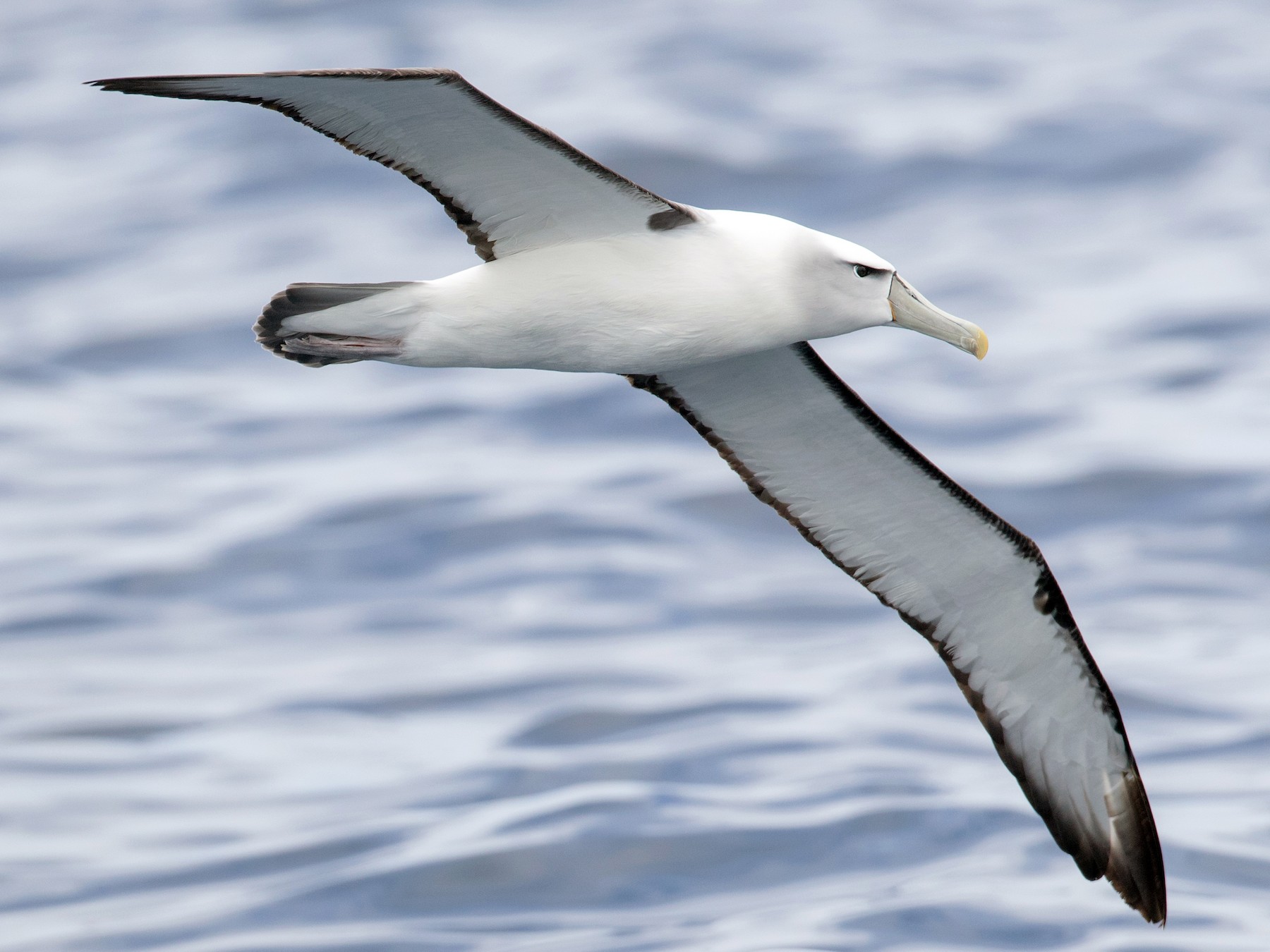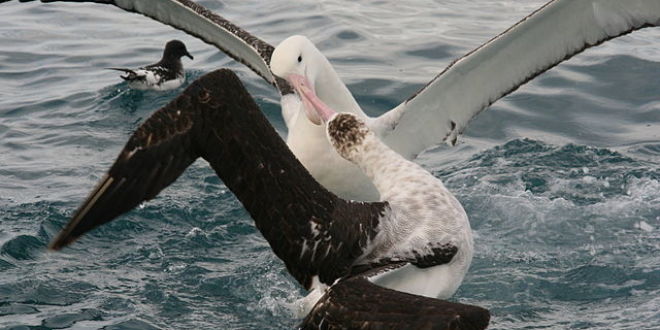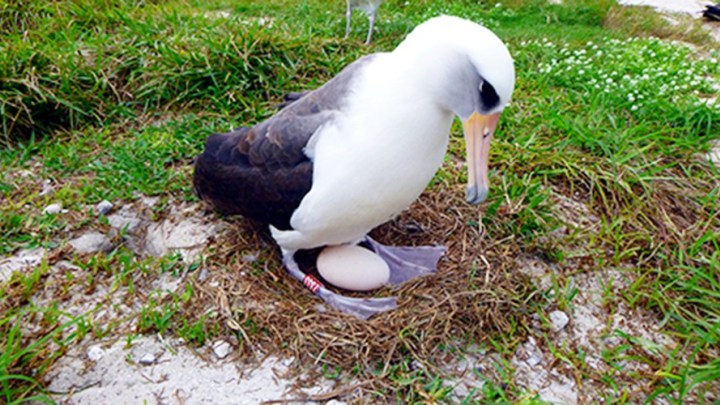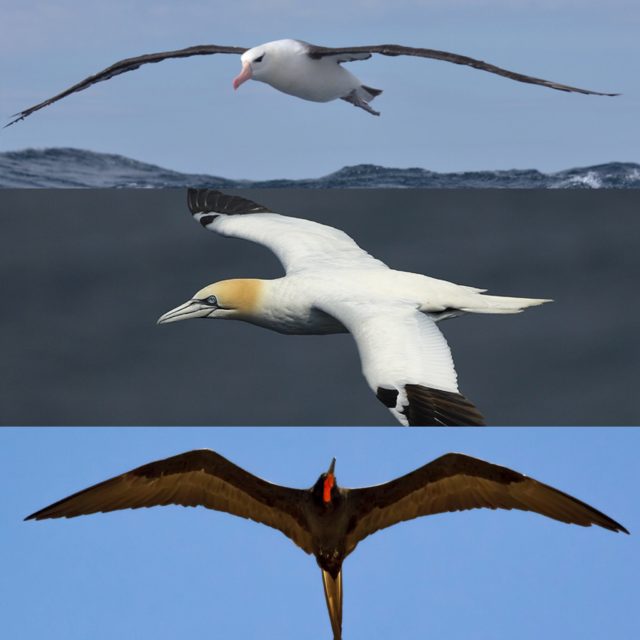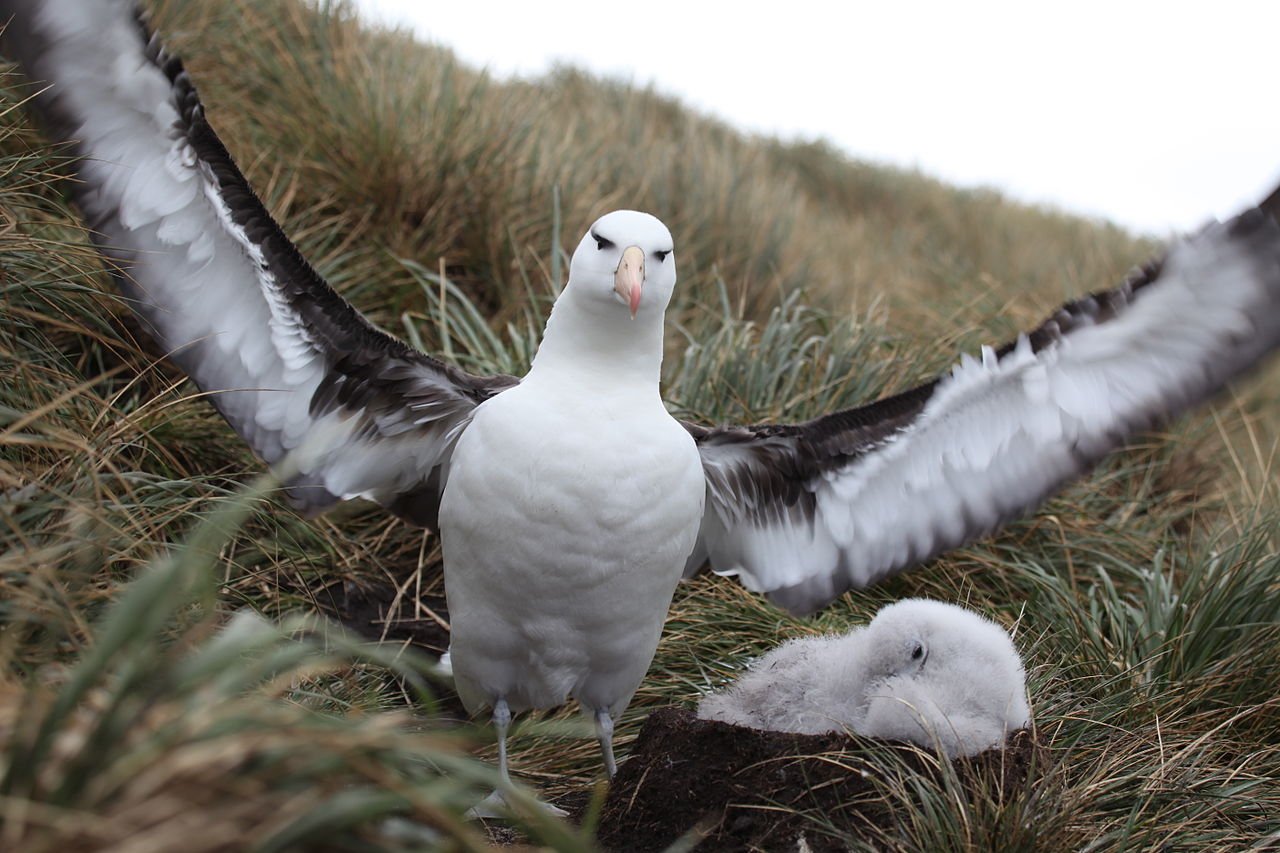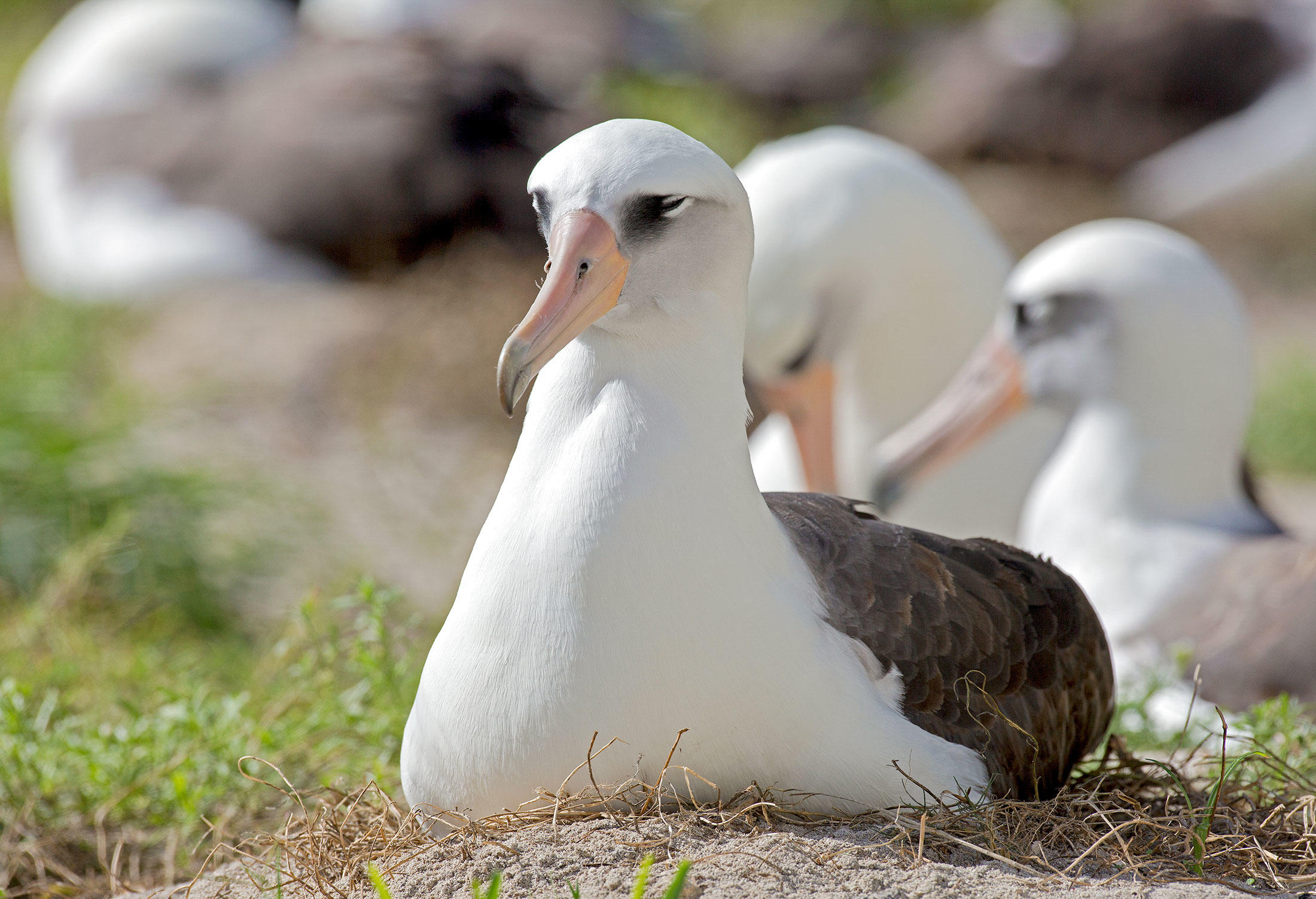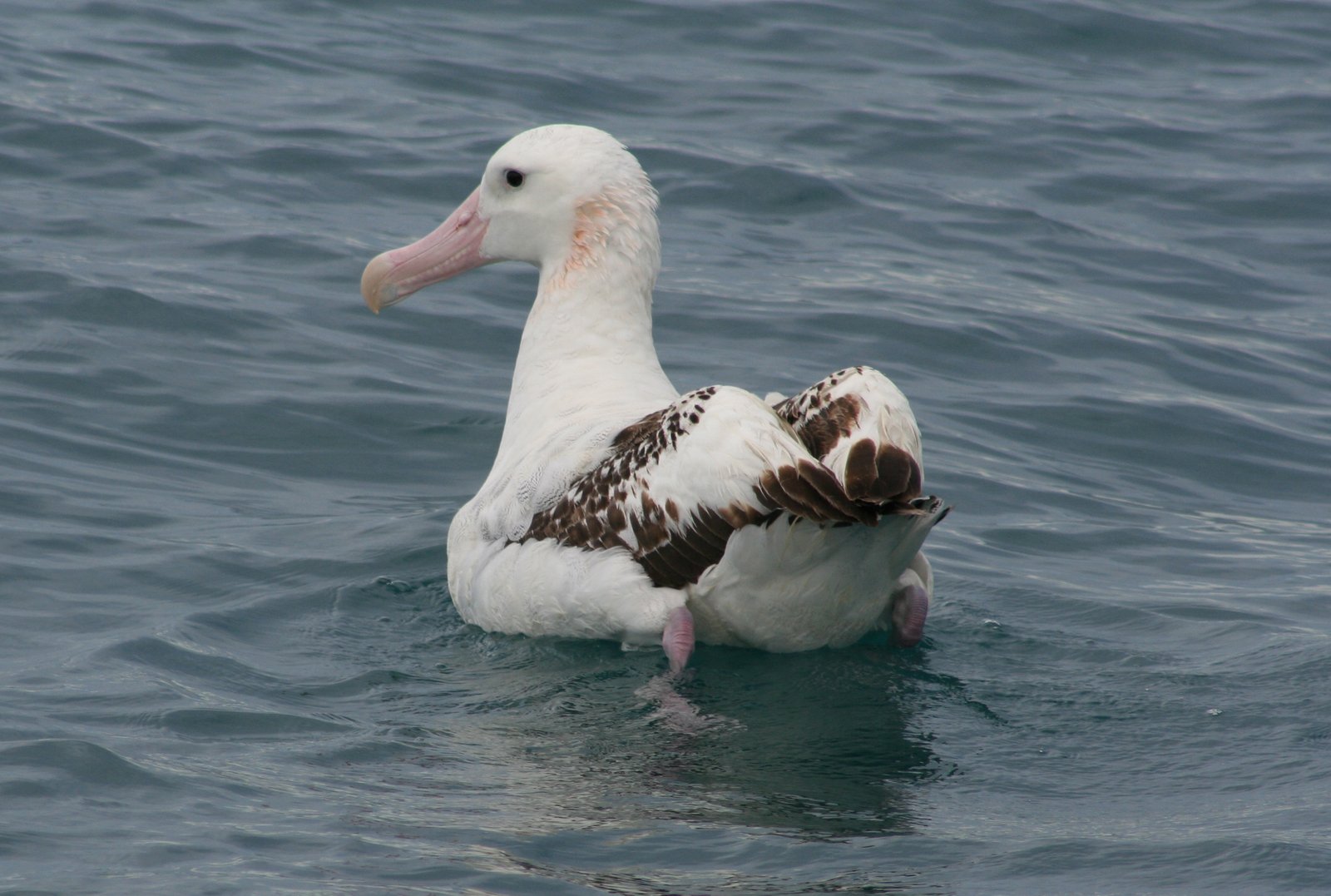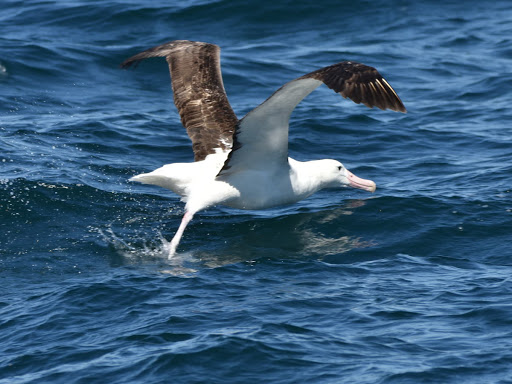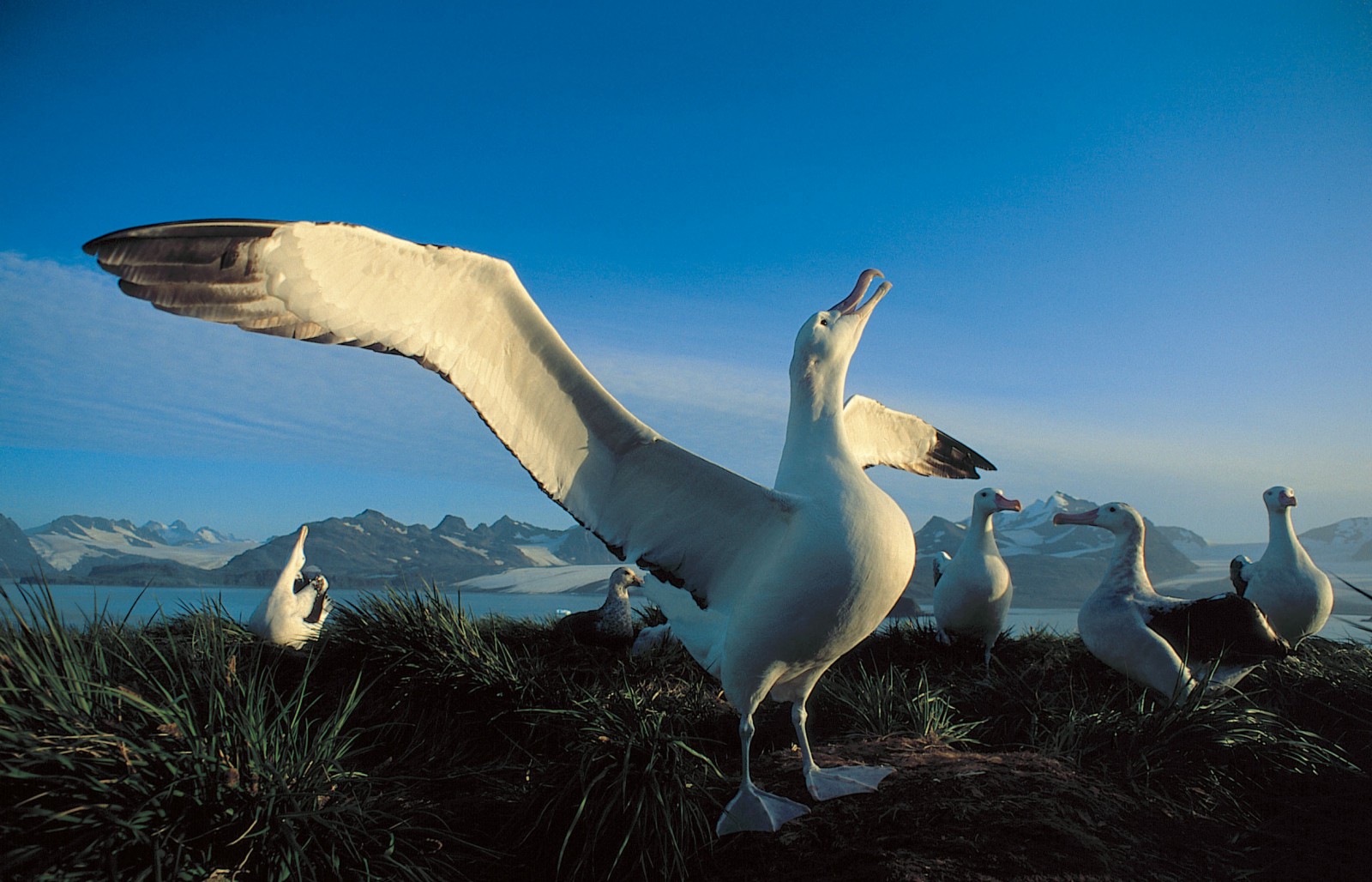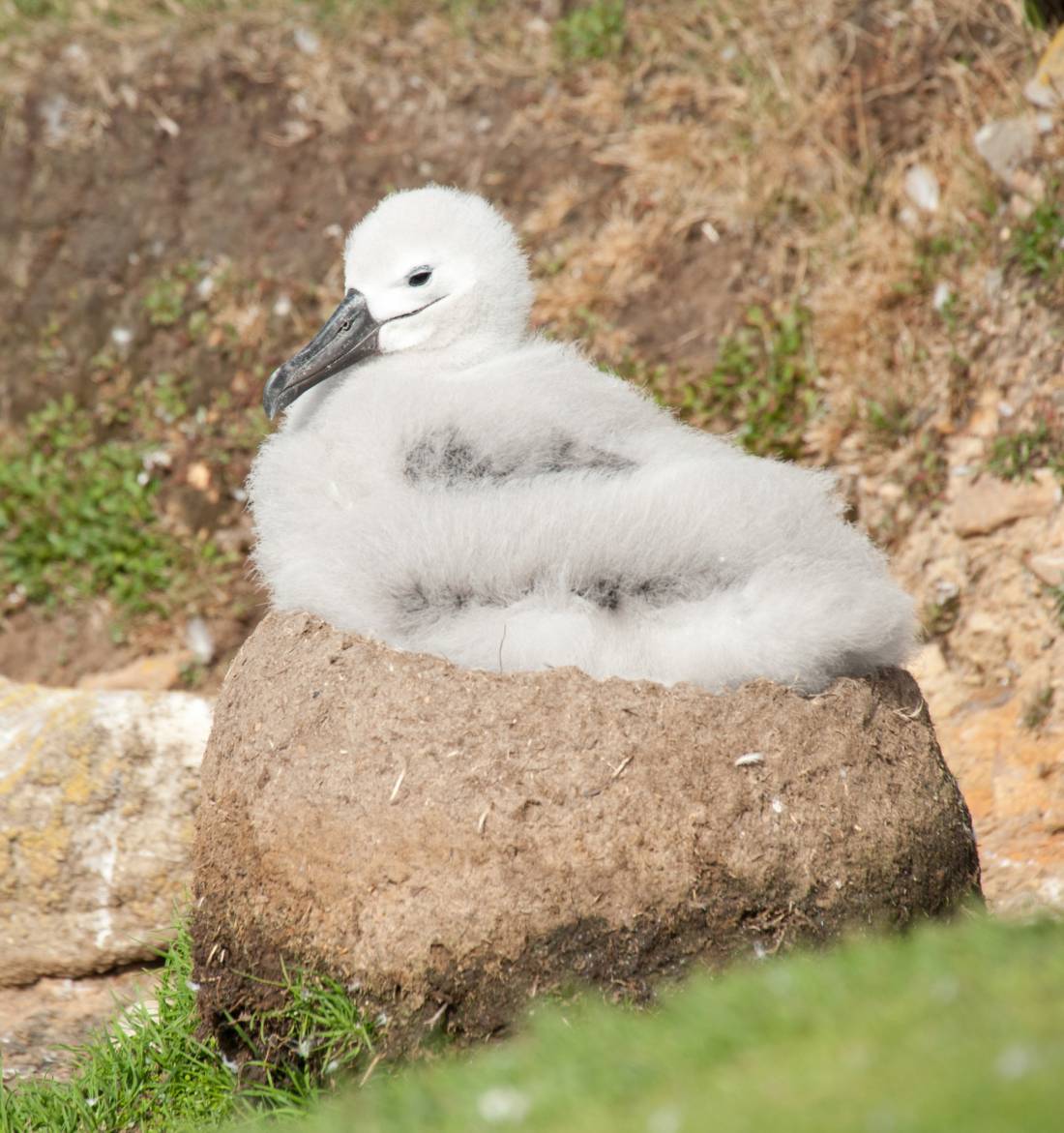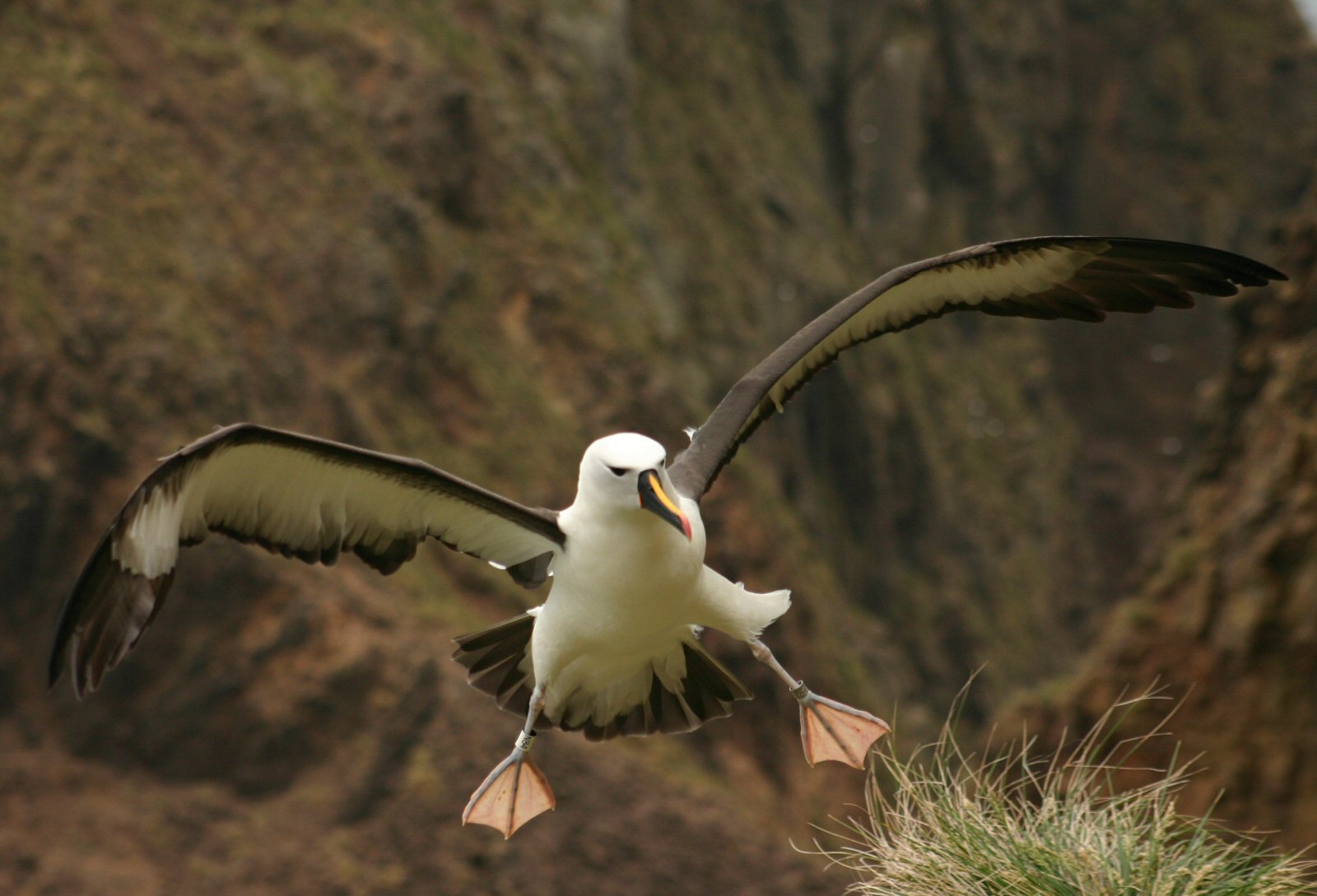Surely you know about the existence of seabirds, such as the pelican and you think they are all very nice, but as scientific studies are carried out on them, very fascinating aspects continue to be discovered and today our article is going to focus on the Albatross and in all the information that we have been able to discover about her.
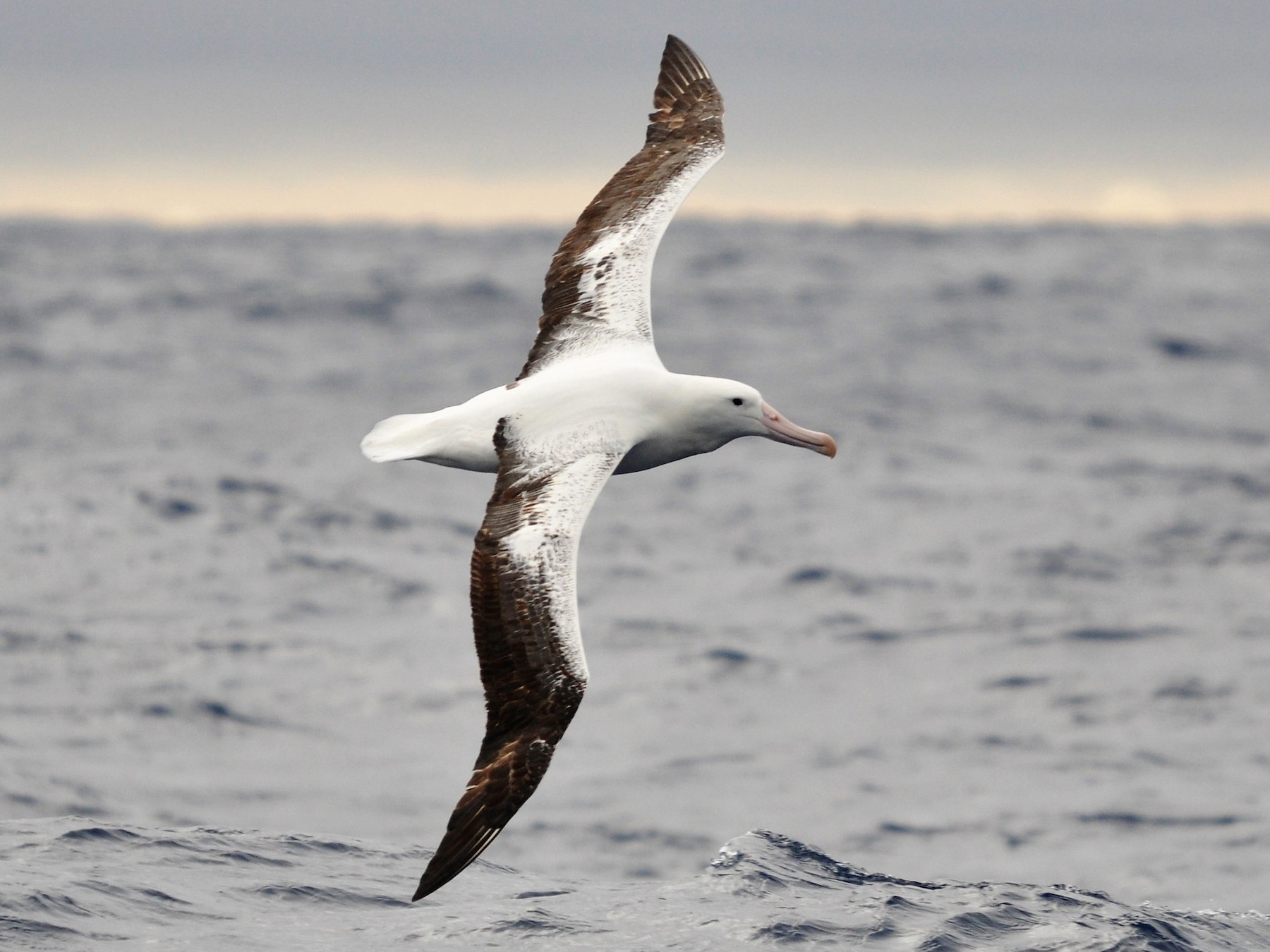
The Albatross
The albatross (Diomedeidae) is part of a species of seabirds that have enormous sizes to be flying birds. The diomedeidae, together with the pelicaboides, hidrobaticos and proceláridos, are part of the order Procellariiformes.
Albatrosses are distributed throughout almost the entire area that covers the Antarctic Ocean, in the Pacific Ocean and in the South Atlantic Ocean, so that their natural habitat is very extensive.
This bird is classified within the set of flying birds that have the largest dimensions of measurements. The bulky albatrosses (of the genus Diomedea) have the largest wing span, larger than any other species in existence today. They are usually classified into four classes, but there is no consensus among scientists regarding the number of species that comprise them.
Albatrosses are characterized by being birds that transport themselves very efficiently through the air and, using them, they have the ability to use a flight technique called dynamic gliding to their advantage, which allows them to cover great distances with the minimum of effort.
Their food consists mainly of some fish, squid and krill, either because they collect dead animals or hunt their food if they find their prey alive on the surface of the water or a short distance from it, because they are also capable of diving into the water and diving. a bit.
Regarding their social behavior, they are gregarious birds, so they live in colonies and have the habit of making their nests on remote oceanic islands, and it is usual for them to share their breeding place with other species. They are monogamous animals, so they live in pairs throughout their existence.
There are twenty-two species of albatross recognized by the IUCN, which is the International Union for Conservation of Nature, whose data indicates eight are in a state of vulnerability, six species are at risk of extinction and unfortunately three are at critical risk of extinction. .
Etymology
In the Spanish language they are called albatrosses, and it is a name that is generally used to designate all the birds that are part of the Diomedeidae family, but the word derives from the English word albatross. In turn, that English word comes from the Portuguese term gannet, which are the birds of the same name and thanks to which the famous North American prison was baptized.
But the derivations do not stop there, because the term gannet comes from the Arabic al-câdous or al-ġaţţās, with which the Arabs designated a pelican and literally means diver. The Oxford English Dictionary explains that the name gannet was initially applied to birds called frigatebirds.
The linguistic modification continues until the term albatross is reached, possibly as a consequence of the use of the word albus, which is a Latinism that literally means white, and which was used to designate albatrosses and contrasts with the color of frigatebirds, which are black. .
The designation of the genus Diomedea, which was used by Linnaeus to name the albatross, alludes to the metamorphosis into birds suffered by those who accompanied the warrior of Greek mythology Diomedes. The name of the order Procellariiformes derives from the Latin word procella, which literally means violent wind or storm.
Taxonomy and Evolution
The Diomedeidae family includes between 13 and 24 species, this is so because the number of species that make it up is still a matter of debate today, and they are divided into four classes: Diomedea (great albatross), Thalassarche, Phoebastria (large albatross). North Pacific) and Phoebetria (sooty albatross).
Of those four classes, scientists think that the North Pacific are a taxon related to the great albatross, while those in the Phoebetria class are closer to the Thalassarche class.
Its taxonomic placement has been the cause of extensive discussion. Sibley-Ahlquist taxonomy places seabirds, birds of prey, and others in the broad order Ciconiformes, but various ornithological organizations in New Zealand, Australia, South Africa, Europe, and North America maintain that they are part of the traditional order of Ciconiformes. the Procellariiformes.
Albatrosses differ from other members of the order Procellariiformes in both their genetic and morphological characteristics, particularly their size, the shape of their legs, and the location of their nostrils.
https://www.youtube.com/watch?v=Dw9xaDdzziI
Among scientists who use taxonomy to classify species, species designations, and genera have used the same way of classifying for over a hundred years. Albatrosses were initially placed in a single genus, Diomedea, but in 1852 the scientist Reichenbach classified them into four different classes, proceeding to regroup and separate species several times.
In this classification modification process, 12 different classes were identified with their respective names in 1965, which were the classes Diomedea, Phoebastria, Thalassarche, Phoebetria, Thalassageron, Diomedella, Nealbatrus, Rhothonia, Julietata, Galapagornis, Laysanornis and Penthirenia.
But also in the year 1965, an attempt was made to order the classification, bringing them together into two genera, the Phoebetria, which are dark albatrosses, which at first glance look more similar to the procellariids, which were appreciated at that time as primitive animals, and Diomedea, which were the rest of the albatrosses.
This new classification was intended to simplify the albatross family, especially with regard to its nomenclature, since it was based on the morphological analysis made by Elliott Coues in 1866, but little attention was paid to it. the most recent studies, even ignoring several suggestions by Coues himself.
Newer studies, which were carried out by the researcher Gary Nunn in 1996, who belongs to the American Museum of Natural History, and by other scientists worldwide, studied the DNA of the mitochondria of the 14 species that had been accepted at that time. , and found that there were four classes, not two.
They found that there were monophyletic groups within the albatross family. Due to this, and in order to make a correct classification, scholars suggested that two names that had previously been used to designate the genus of these birds be used again.
Finally a consensus was reached, using the name Phoebastria to designate the albatrosses that inhabit the North Pacific; and Thalassarche, keeping the names of Diomedea, for the great albatrosses, and the sooty albatrosses were designated in the class Phoebetria.
Nunn's proposal was accepted by the British Ornithologists' Union and by the South African ornithological authorities, dividing albatrosses into four genera, and the modification has been accepted by most scientists.
But, although there seems to be a consensus regarding the existence of four species or genera of albatrosses, where there is no agreement is in relation to the number of existing species. Contributing to this is the fact that, historically, up to 80 different taxa have been described by various researchers; but it has been verified that a large part of these taxa were the product of misidentifications of juvenile specimens.
Based on the conclusions reached in relation to the definition of genera or classes, Robertson and Nunn made a taxonomic classification proposal in 1998 that includes 24 different species, which differed from the 14 that had been accepted until now. that moment.
That tentative taxonomic proposal raised many subspecies to species status, but was widely criticized for not taking into account, in each case, the information that was subject to peer review by other scientists, who felt that the divisions did not they were justified.
Research since then confirmed some cases, but also contradicted others in Robertson and Nunn's taxonomic review; for example, a 2004 analysis, based on mitochondrial DNA analysis, was able to confirm the hypothesis that the Antipodean albatross (Diomedea antipodensis) and the Tristan albatross (Diomedea dabbenena) were different from the wandering albatross (Diomedea exulans), according to Robertson and Nunn.
But it also showed that the hypothesis suggested by Robertson and Nunn in relation to Gibson's albatross (Diomedea gibsoni) was wrong, because it was not different from the Antipodean albatross.
Many organizations, including the IUCN, and various scientists have accepted the provisional taxonomic classification of 22 species, although there is still no unanimous scientific opinion on the matter.
In 2004, researchers Penhallurick and Wink did a study that suggested reducing the number of species to 13, including merging the Amsterdam albatross (Diomedea amsterdamensis) with the wandering albatross, but that suggestion was highly controversial for the rest. of the scientific community. What the researchers agree on is that there is a need to carry out complementary studies in order to classify this issue.
The molecular study of Sibley and Ahlquist, in relation to the families of birds, places the evolution of the Procellariiformes, to adapt to their environment, in the Oligocene period, approximately between 35 and 30 million years ago, although it is very possible that this group of birds was born a little before those dates.
That conclusion was reached when a fossil bird was found, classified by some scientists as belonging to the Procellariiformes. Specifically, it is a seabird to which the name Tytthostonyx was attributed, which was discovered inside rocks from the Cretaceous period, which took place 70 million years ago.
Molecular investigations have concluded that the storm-petrels were the first to split from the primitive lineage, followed later by the albatrosses, with the procellariids and pelecanoids, which split later.
The oldest albatross fossils have been found inside rocks dating from the Eocene to Oligocene stages, although some specimens are tentatively related to that family and none of them resemble today's species.
The fossils found belong to the genera Murunkus (Middle Eocene of Uzbekistan), Manu (Early Oligocene of New Zealand), and an undescribed form from the Late Oligocene of South Carolina. Similar to the latter would be Tydea, from the early Oligocene (Rupelian) of Belgium.
Fossils found belonging to the genus Plotornis, previously classified as petrels, were later classified as albatrosses, but that classification is now in doubt. They belong to the French Middle Miocene era, which was a time when the division of the four genera that currently exist would have already begun.
This conclusion was reached after observing the fossils of Phoebastria californica and Diomedea milleri, which belong to the Middle Miocene of Sharktooth Hill, California. This proves that the division between the great albatrosses and the North Pacific albatrosses took place 15 million years ago. Similar fossils found in the Southern Hemisphere have been able to date the split between the Thalassarche class and the Phoebetria class to 10 million years ago.
The fossil record of the finds found in the Northern Hemisphere turns out to be more complete than those of the Southern Hemisphere, and many fossil forms of albatrosses have been found in the North Atlantic region, a place where these birds do not survive today.
Remains of a colony of short-tailed albatrosses have been found on an island that is part of Bermuda. Most of the North Atlantic fossils belonged to the genus Phoebastria, the North Pacific albatrosses. One of them, Phoebastria anglica, was found in fossil beds located in North Carolina and England.
Species
Despite the debates, today the division of the Diomedeidae family into four classes or genera is peacefully accepted by the scientific community, despite which the number of existing species is still subject to discussion. The International Union for Conservation of Nature (IUCN) and Birdlife International, among other organizations, recognize the provisional taxonomy of the 22 extant species.
For their part, other authorities recognize the existence of the 14 traditional species and the taxonomic classification of Clements indicates that there are only 13.
Below we will list the species whose existence is recognized by the International Union for Conservation of Nature (IUCN):
Diomedea exulans (wandering albatross)
Genus Diomedea
- exulans (wandering albatross)
- (exulans) antipodensis (antipodean albatross)
- (exulans) amsterdamensis (Amsterdam Albatross)
- (exulans) dabbenena (Tristan Albatross)
- epomophora (royal albatross)
- (epomophora) sanfordi (northern royal albatross)
Genus Phoebastria
- irrorata (Galapagos albatross)
- albatrus (short-tailed albatross)
- nigripes (black-footed albatross)
- immutabilis (Laysan Albatross)
Genus Thalassarche
- melanophrys (haggard albatross)
- (melanophrys) impavida (Campbell's Albatross)
- cauta (white-crowned albatross)
- (cautious) steadi (Auckland Albatross)
- (cautious) hermit (Chatham albatross)
- (cauta) salvini (Salvin's albatross or white-fronted albatross)
- chrysostoma (grey-headed albatross)
- chlororhynchos (slender-billed albatross or chlororhyncho albatross)
- (chlororhynchos) carteri (yellow-billed albatross)
- bulleri (Buller's albatross or gray albatross)
Genus Phoebetria
- fusca (dark albatross)
- palpebrata (sooty albatross).
The classes or species of the genera Thalassarche and Phoebastria are sometimes placed in the genus Diomedea, which is why we can find that they are called by the name of Diomedea melanophrys, instead of having the name of Thalassarche melanophrys.
Biology
Regarding the biology of albatrosses, there are many interesting aspects, related to their shape and the way they fly, as well as their natural habitat, way of feeding and reproduction and we will treat each one in particular.
Morphology and Flight
Albatrosses are a group of birds whose dimensions range from large to very large wingspans, depending on the class or species we are observing. From a scientific point of view, they are the largest birds in the Procellariiformes family.
Its bill is strong, large, and pointed, with an upper jaw that ends in a large hook. The beak is made up of several horny plates, called ranphothecae, and on the sides of the beak they have two nostrils that are shaped like tubes, through which they get rid of the salt and that was the reason why they were given the old name of the order Procellariformes that It was Tubinaires.
The two tubular nostrils of albatrosses are placed along both sides of the beak, unlike the rest of the Procellariiformes, in which the tubes are only located in the upper part of the beak. Those tubes make it possible for albatrosses to have a particularly fine-tuned sense of smell, something that is highly unusual among birds.
Like the other classes of Procellariiformes, they use their excellent sense of smell to find potential prey to feed on. Albatrosses, as is the case with the rest of the Procellariiformes, need to reduce the salt content that could accumulate in their bodies due to the seawater that enters through their beak when they eat their food.
This is thanks to a large nasal gland that all birds have at the base of their beaks, in the upper part of their eyes, which has the function of eliminating salt through their nostrils. This gland becomes inactive in those species that do not require it, but in albatrosses they have developed, because they need to use them.
The legs of the albatrosses do not have an opposite toe on the back, and the three anterior toes are absolutely united by an interdigital membrane, with which they can swim, it also allows them to perch and take off using the water as sustenance.
Its legs are extremely strong when compared to other birds that are part of the Procellariiformes family. Moreover, among the members of this order of birds, only albatrosses and giant petrels are the ones that can move effectively on land. In fact, albatrosses, like this black-footed albatross (Phoebastria nigripes), can easily move on the ground.
The plumage of most adult albatrosses differs in that they have a dark color on the upper part of their wings, but on the lower part the feathers are white, in a similar way to the feathers of seagulls.
This distinction can be found differently, depending on the species of albatross we are analyzing, from the royal albatross (Diomedea epomophora), which appears to be totally white except for the males, which have another color on the tips and on the hind end of his wings.
At the other extreme is the adult Amsterdam albatross (Diomedea amsterdamensis), which has a plumage very similar to that of the young specimens, in which the brown colors stand out, particularly in a flock, in which we can observe that these colors are stand out around the chest.
Several species of the class Thalassarche and North Pacific albatrosses have markings on their faces, and can be seen to have spots around their eyes, or ash-colored or yellow spots on their heads and nape.
There are three species, which are the black-footed albatross (Phoebastria nigripes) and the two species of dusky albatross (genus Phoebetria), whose plumage differs completely from the usual patterns and appears dark brown almost all over its body, or dark gray in some areas, as occurs with the sooty albatross (Phoebetria palpebrata). It takes several years for their plumage to reach the color that adults should have.
The size of the extended wings of the largest albatrosses (genus Diomedea), exceeds that of all existing birds today, because they can exceed 3,4 linear meters, although within that family there are species whose wingspan they have a much smaller wingspan, about 1,75 m.
Its wings are stiff and arc-shaped, with a thick, highly aerodynamic front section. Thanks to this, they can cover enormous distances, using two flight techniques that are very well known to several seabirds that have large wings: dynamic gliding and slope gliding.
Dynamic gliding allows them to reduce the effort required for flight by passing the division between air masses several times with an appreciable difference in horizontal speed using a high air gradient.
In slope flight, the albatross can take advantage of the rising air currents that are the product of the wind when it encounters an obstacle, such as a hill, and faces the wind, which allows it to gain altitude and glide on the surface in a row of the water.
Albatrosses enjoy a very high glide ratio, approximately 1:22 to 1:23, meaning that for every meter they descend, they can move 22 to 23 meters forward. They can achieve that glide ratio because It helps them in gliding to be able to have a tendon-type membrane that locks each wing when it is fully open.
This special tendon allows them to keep the wing extended without having to make any extra muscular effort. This morphological adaptation of the tendon is also found in giant petrels (genus Macronectes).
It is not usual that they need to flap their wings to fly. In fact, takeoff is one of the few moments in which albatrosses need to flap their wings to fly, but it is also the most demanding period in terms of energy consumption during the flight carried out by these birds.
Albatrosses manage to combine these techniques when flying with the use of innate systems that they possess to predict the state of the weather. It has also been observed that the albatrosses of the Southern Hemisphere fly towards the North and when they depart from their colonies they do so following their route in a clockwise direction, on the contrary, those that fly towards the South do so following the counterclockwise direction.
These are birds that have adapted so well to their lifestyle that they have achieved that their heart rate levels recorded during their flight are practically the same as those recorded when they are at rest. They have achieved such a body efficiency that it is not in the distance traveled when they go looking for food that they consume their greatest energy expenditure, but in the moments of takeoff, landing and catching food.
The success of albatrosses as bottom hunters is due to the fact that they manage to make very efficient long-distance trips, which allows them to cover great distances, without spending much energy in the search for their food sources, which are located in a dispersed manner in the ocean. Having managed to adapt to planning in their flight makes them, however, be dependent on the existence of the wind and waves.
Most of the species do not have morphological and physiological conditions that make it easier for them to maintain a constant flight by actively moving their wings. If they are in a calm situation, they are forced to remain at rest on the surface of the water until the wind picks up again.
They can only sleep when they are in the water in a state of rest, but never while flying, as some researchers have even speculated. Albatrosses in the North Pacific have been able to use a type of flight in which they can alternate times when they flap their wings vigorously, when they gain more altitude, with times when they are dedicated to gliding in the air.
Another characteristic is that at the time of takeoff, they need to make a race to get enough air to pass under their wings, thus creating the aerodynamic lift they need to be able to take flight.
Habitat and Distribution Area
A large part of the albatrosses is distributed in the southern hemisphere, in a distance that covers from Antarctica to Australia, South Africa and South America. The exception to this location can be seen in the four species whose habitat is the North Pacific, three of which are endemic species to that region, and are distributed from Hawaii to Japan, California and Alaska.
Only one, the Galapagos albatross, nests only on the Galapagos Islands and reaches the South American coast to feed. As they require the wind, which they need for their type of gliding flight, it makes sense that their habitat is in high latitudes, because these birds are not physiologically designed to fly by flapping their wings, which is why they find it very difficult to cross the intertropical convergence zones.
But, the Galapagos albatross species is able to have its habitat in equatorial waters, around the Galapagos Islands, thanks to the cold waters produced by the Humboldt current and the winds that result from it. is that the habitat of the albatross is distributed over large oceanic expanses and it is normal for them to make trips that cross the poles.
It has not been possible to find the real reason why the albatrosses became extinct in the North Atlantic, but it is speculated that an increase in the average level of ocean waters, caused by a period of interglacial heating, could have caused the flooding of the places where they were found. They found the habitat of a colony of short-tailed albatrosses that was found in the Bermuda Islands.
Occasionally, some southern albatross species have been observed acting erratically in the North Atlantic, remaining in exile in that area for decades. One of these confused living exiles, which was a black-browed albatross, returned for several years to a colony of gannets (Morus bassanus) located in Scotland, making vain attempts to reproduce.
Using a satellite tracking system, researchers have been provided with a very important collection of information regarding their journeys in search of their food, which they make across the ocean. It is true that they do not make an annual migration, but they do disintegrate after the breeding season, while in the case of the species from the southern hemisphere, it has been proven that they make multiple trips through the polar region.
Evidence has also been collected on the dispersion of the distribution areas of the different species in the ocean, managing to collect data on the feeding habits of two species that reproduce on the Campbell Islands: the gray-headed albatross and Campbell's albatross .
Available information proves that the former obtains its food essentially from the Campbell Plateau, but the latter shifts its search for food to waters with particularly oceanic and pelagic characteristics.
Regarding the wandering albatross, it also has a very specific reaction to the bathymetry of the place where it obtains its food, and obtains its food only in waters that are deeper than 1000 m.
These data, which were obtained via satellite, have allowed scientists to configure a habitat with borders so defined that one researcher even stated that he had the impression that it almost seemed that the birds could see and obey a sign of prohibited passage in the areas. oceanic whose depths are less than 1000 meters.
They have also found evidence of the existence of different distribution areas for each sex of the same species. An analysis of the Tristan albatross breeding on Gough Island proved that males travel west while females travel east.
Food
In the diet of albatrosses, their favorites are made up of crustaceans, cephalopods and fish, although it has been shown that they are also scavengers and can supplement their diet with zooplankton. It should be taken into account that for a large volume of species, it has only been possible to know the diet that they carry during the procreation and breeding period, because that is the time in which they regularly return to land, which has facilitated their study. .
The inclusion of some food sources has a different relevance, because the consumption of some types of food changes significantly between one species and another, it is also different from one colony to another. Thus, it has been observed that some species base their diet on squid, while other species base their food on a large quantity of fish or krill.
This substantial difference can be seen in two species of albatross that have their habitat in the Hawaiian Islands, they are the black-footed albatross, whose staple food source is fish, but in the case of the Laysan albatross it feeds almost exclusively on squid.
In the case of sooty albatrosses (Phoebetria palpebrata) it has been proven that they dive an average of 5 meters to feed, mainly on fish, although it has been established that they could dive up to 12 meters deep.
It has been possible to use devices in the ocean that have been able to establish the amount of water that albatrosses ingest in the course of their lives, for which it has been possible to establish the average of the estimated duration of their feeding, concluding that they are diurnal animals. , because the feeding process is carried out during the day.
Another curious fact is that the analysis of squid beaks that have been regurgitated by albatrosses proved that some of the squid that were ingested were too large for the bird to have captured them alive, from which it is concluded that they are also scavengers and that this activity is very important in their diet, as is the case with the wandering albatross.
In addition, they have been shown to eat squid species that inhabit the mesopelagic area, which has a depth that is outside the range of action of the albatross.
Researchers have wondered about the origin of the dead squid consumed by albatrosses, but there is still no clear answer, in fact, this has been a source of controversy.
Some maintain that it is the product of man's fishing exploitation, although a relevant and natural cause may be the mortality of squid that occurs after spawning or the frequent vomiting of cetaceans that feed on these cephalopods, as occurs in the case of whales. bottlenose, pilot whales or sperm whales.
The feeding of other species, as occurs with the black-browed albatross or the grey-headed albatross, are particularly smaller species of squid that have a tendency to sink after their death, concluding that in this case necrophagy is not an activity relevant to your livelihood.
Particularly interesting has been the behavior that has been observed in the Galapagos albatross, which harasses booby birds to take away their food, proving that this species is opportunistic, and at the same time makes this albatross the only member of the Procellariiformes who uses kleptoparasitism with discipline.
A short time ago, it was believed that albatrosses were birds that dedicated themselves to collecting on the surface, swimming parallel to the water, to catch fish and squid that were transported to the surface by sea currents, by predators or simply because they died.
Thanks to the fact that capillary depth gauges have been invented and used, which have been able to be attached to the body of albatrosses and have been removed when they return to land, and with which the maximum depth of immersion reached by the birds included in the study can be measured , it has been proven that not all species dive to the same depths and that they use different techniques to do so.
For example, it has been shown that some species, such as the wandering albatross, do not dive more than a meter deep, while others, such as the sooty albatross, can dive very deep, registering from 5 meters to 12,5 meters. .XNUMX meters. In addition to surface feeding and diving, albatrosses have been observed diving by diving from the air to catch their prey.
Reproduction
We have already said that albatrosses are gregarious animals, which form colonies on remote islands, where they make their nests, sometimes sharing the area with other kinds of birds. In the case of those that prefer to stay on the mainland, it has been observed that they prefer to make their nests on breakwaters or promontories that have good access to the sea in multiple directions, as is the case on the Otago Peninsula in Dunedin, New Zealand.
Many gray albatrosses and black-footed albatrosses rarely nest under trees in open woodland. The conformation of the colonies is also changing from one species to another. We can observe very dense accumulations, which are typical of the albatrosses of the Thalassarche genus, which are the colonies of black-browed albatrosses in the Malvinas Islands, whose group has an average population density of 70 nests per 100 m².
Even much smaller groups and with individual nests that are very far apart, and that are typical of the Phoebetria and Diomedea genera. The colonies of these two types of albatross are located on islands where land mammals have not historically existed.
Another condition that characterizes them is that albatrosses are very philopatric, which means that they generally return to their birth colony to reproduce. This habit is so powerful that a study on the Laysan Albatross proved that the average distance between the hatching site of the egg from which it hatched and the place where the bird will later establish its own territory is 22 meters.
Like many seabirds, albatrosses continue the K strategy throughout their life cycle, i.e. a low birth rate, offset by a relatively long life expectancy, delaying the opportunity to breed and investing more effort in fewer pups.
Their life expectancy is particularly long, as most species can live beyond 50 years. The specimen that was recorded with the greatest number of years of life was a northern royal albatross, which was ringed when it was already an adult and managed to survive for 51 more years, after being marked, which has allowed scientists to speculate that he could live around 61 years.
Since the vast majority of scientific research involving bird banding for tracking purposes is more recent than the case cited above, it is very likely that other species will be found to have life expectancies that are similar or that may be greater.
The sexual maturity of these birds is obtained after a relatively long period of approximately five years, but the mere passage of time does not cause them to start procreating, on the contrary, they will not join their partner until a long time has passed, in some species take up to ten years to settle, and when they find their mate, they establish a lifelong monogamous relationship.
Studies carried out on the behavior of the Laysan albatross showed that if there are important fluctuations in the sexual proportion of the population, due to insufficient male specimens, its social structure can undergo changes and cooperative behavior for incubation and rearing of chicks may appear. between two females.
This behavior is a bit strange, taking into account that the albatross is a bird that has monogamous habits and that its lifestyle is to form a couple with a male for life, but it has been established that the two females that have shared the incubation and rearing of chicks tend to stay together, prolonging that life in common for years, which is very rare, since there is no relationship or kinship between them.
The young that are not yet in the breeding phase usually join the colony before they begin to reproduce, acquiring skill over a few years in the practice of the very complicated mating rituals and the well-known characteristic dances of this species. family they run to attract females. One of the movements in the mating ritual of the Laysan Albatross is to assume a position with the neck and bill up.
Albatrosses that return to their birth colony for the first time show that they already observe the behaviors that form the language of the albatrosses that reside there, but they are not able to notice the behavior that other birds show, nor respond to them in an appropriate way. .
It has been shown that young birds are subjected to a period of trial and learning using the trial and error method, with which the young birds are able to perfect the mating ritual and dances. Body language can be learned more quickly if a young bird is in the company of an older bird.
Compilation of these behaviors requires a synchronized performance of multiple actions, such as grooming, pointing in certain directions, calls, producing various beak-beating sounds, staring, and relatively complex mixtures of several of these behaviors. at once.
When an albatross first returns to its birth colony, it performs a dance with many partners, but after a few years, the number of birds it establishes a relationship with decreases, until it chooses only one partner and they will continue perfecting a individual language, which will end up being unique for that couple. If we take into account that this couple will establish a monogamous relationship for life, most of these dances will never be repeated.
It is speculated that the reason why they carry out these complicated and meticulous rituals and dances is to be sure that they have selected the right partner, and to be able to better recognize their partner in the future, since for them it is an extremely difficult task. It is important to have the right partner at the time of laying the eggs and for the care of the young.
It has also been observed that in species that can have a complete reproductive cycle in a period of less than a year, it is very rare for them to procreate again in the following years. The great albatrosses, such as the wandering albatross, use a period of more than a year to take care of their offspring, from egg laying, until it reaches its plumage.
Albatrosses lay a single egg in the breeding season, this egg is subelliptical in shape, and is white with reddish brown spots. The largest eggs weigh between 200 and 510 grams. In the event that they lose the egg, either by accident or because of a predator, they will not try to have a young again during that year.
Due to the reduction in the rate of reproductive success and the monogamous relationships that they establish, the separation of pairs that are already established is very infrequent among albatrosses and it usually happens that they do not succeed in reproduction until several years have elapsed. years trying unsuccessfully.
But when they successfully have a young, the albatrosses care for and protect them until they are big enough to defend themselves and thermoregulate. In this process the offspring will have enough weight to equal that of their parents.
All albatrosses in the southern regions build large nests for their eggs, using grasses, shrubs, soil, peat, and even penguin feathers, but the three North Pacific species build nests of more rudimentary form.
For its part, the Galapagos albatross does not build any type of nest and even moves its egg through the entire breeding territory, which sometimes reaches up to 50 meters, as a result of which, sometimes, the egg strays. In all species of albatross, both parents incubate the egg for periods that can last from one day to three weeks.
Like kiwis, albatrosses have the longest incubation period of any bird. Incubation lasts about 70 to 80 days, and in the case of great albatrosses it lasts a little longer. This process produces a great energy expenditure in them and can lead to an adult losing up to 83 grams of weight in a day.
After hatching from the egg, the offspring, which is semi-altricial, so it is hatched and protected for three weeks, until it reaches an adequate size to be able to defend itself and thermoregulate itself. During this period, the parents will proceed to feed the chick with small amounts of food at the time the shift changes to be cared for.
When the brooding period of the offspring has ended, it will receive food from its parents at regular intervals, which normally alternate short and long trips to find food, in order to be able to provide their offspring upon their return from each trip a food that weighs around 12% of their body mass, which is calculated around 600 grams.
The diet of the hatchlings is made up of krill as well as squid and fresh fish, in the form of albatross stomach oil, which is a lighter energy food and easier to transport than having to transport the prey caught without digesting it. This oil is formed in an organ of the stomach that most Procellariiformes have and that receives the name of proventriculus, with the captured prey digested and giving them their characteristic musty smell.
The chicks usually take a long time to fledge. If we refer to the great albatrosses, this process can take up to 280 days. Even in the case of the smallest albatrosses, it takes between 140 to 170 days.
As with many species of seabirds, albatross chicks will eventually gain enough weight to catch up with their parents, and in order to properly use additional food reserves to increase their body weight. and their size, as well as achieving the optimal growth of their plumage, which is necessary to be able to have skill in flight, the process of fletching occurs only when they are a size similar to that of their parents.
Depending on the class or species, between 15% and 65% of those that manage to have their plumage survive long enough to reproduce. The young achieve their fledging process alone, and will not have any additional help from their parents, who they will return to when the hatchling is fully plumaged, not realizing that their hatchling is already gone.
When they leave the nest, there are studies related to the disintegration of young birds by the ocean that have allowed scientists to speculate on the existence of an innate migratory behavior, as if there were a navigation route encoded in their genes, which allows them orient themselves at sea when they first venture out into the ocean.
albatrosses and man
Albatrosses have been called the most legendary of all birds. An albatross is the central character in the famous poem Rime of the Ancient Mariner, written by Samuel Taylor Coleridge; a captive albatross is also a metaphor for the poète maudit in Charles Baudelaire's poem, The Albatross. The use of the albatross as a metaphor in the English language comes from Coleridge's poem.
To a lesser extent, it has also inspired Spanish-language authors, a language in which it is customary to say that when someone has a heavy load or problem, then they have an albatross around their neck, which was the punishment imposed in the poem on the sailor who killed the albatross.
The myth developed among sailors is known that the albatross is a bird of good luck and that it can result in a calamity to kill or harm it and it was a widespread belief that they embodied the souls of sailors who died at sea. In reality, however, it has shown us that they were regularly killed and eaten by sailors. Maori tribes used their wing bones to carve ceremonial skin tattoos and to carve their flutes.
These are birds that are highly esteemed by those who are fond of ornithology and the places where they establish their colonies become popular destinations for ecotourism. There are many coastal cities and towns such as Kaikoura, Sidney, Wollongong or Monterey, where pelagic seabird watching trips are made, and albatrosses are often easily attracted to these tourist boats by throwing fish oil into the sea.
Visiting the colonies of these birds is a well-known tourist destination; the northern royal albatross colony at Taiaroa Head in New Zealand attracts 40 visitors a year, and the more isolated colonies have become regular tourist attractions on sub-Antarctic island cruises.
Threats and Conservation
Despite being considered birds of legend, albatrosses have not been able to be excluded or protected from the direct and indirect effects that we humans produce. When they were discovered by the Aleuts and the Polynesians, they were thoroughly used to hunt them, until they disappeared from some islands, as happened on Easter Island.
As Europeans began to sail across the planet, they began to hunt albatrosses as well, fishing them off ships to use for food, or simply shooting them for sport or fun.
This custom of shooting them reached its peak on the emigration routes to Australia and could only be stopped when the boats became so fast that it became impossible to fish from them and when regulations were established that prohibited the use of weapons. of fire on board ships for safety reasons.
In the XNUMXth century, albatross colonies, especially those in the North Pacific, were decimated for the feather trade, driving the short-tailed albatross to near extinction.
As we stated at the beginning of this article, of the 22 albatross species that have been recognized by the International Union for Conservation of Nature (IUCN), 8 are in a state of vulnerability, 6 are at risk of extinction and 3 are critically endangered.
The three species at critical risk of extinction are the Amsterdam Albatross (Diomedea amsterdamensis), the Tristan Albatross (Diomedea dabbenena) and the Galápagos Albatross (Phoebastria irrorata). One of the main threats to these birds is commercial longline fishing.
This is because albatrosses and other seabirds that feed on the debris are attracted to the bait of the longline, unfortunately snagging on the lines or hooks and drowning. About 100 albatrosses are killed each year in this way. Even more serious is what happens with the cases of pirate fishing, which by not complying with any regulation, make the problem even more serious.
Another human activity that represents a danger to the albatross is aviation. For example, on Midway Atoll there have been many collisions between Laysan albatrosses and aircraft, causing the death of humans and birds, as well as serious paralysis in military flight operations.
To try to avoid these accidents, studies were carried out at the end of the 1950s and the beginning of the 1960s that analyzed the results that it would bring to be able to place various control methods and systems, unfortunately concluding with the killing of birds and the annual destruction of their sites. to nest, or modifying the orography of their colonies, by leveling and clearing the land to exclude the ascending air currents used by these birds in their flight.
Another idea was the use of elevated structures, such as traffic control towers and communications towers, which killed 3000 birds in in-flight collisions between 1964 and 1965, before the towers were lowered. . Unfortunately, every time that man has tried to solve the problem, it has meant a considerable decrease in the populations of these birds.
The definitive closure of the naval aviation facilities in the Midway Islands in 1993 ended the problem of albatross collisions with military aircraft. In addition, the minimization of human activity on the islands as a result of the closure of base activities has helped to reduce the number of bird deaths.
Another problem is introduced predators on the islands and lead-based paint contamination around military buildings, all of which have more than likely killed thousands of birds. In addition, its feathers were highly prized at the beginning of the 1909th century. In 300 alone, more than 000 of these birds were hunted on Midway and Laysan Islands for that reason.
Regarding the threat from introduced species, such as rats or feral cats, we must say that they directly attack albatrosses or their eggs and young. It should be noted that albatrosses evolved to have their breeding sites on islands that did not have terrestrial predators, which is why they did not develop defensive systems against them.
The influence of these animals is so harmful that even species as small as mice can be very harmful; for example, on Gough Island, which is one of the largest seabird colonies on the planet, Tristan albatross chicks are attacked and eaten alive by house mice that have been introduced to the island.
Introduced species may produce other indirect effects. This is the case of the cattle that devour the essential layer of grass on the islands of São Paulo and Amsterdam, which has placed the Amsterdam albatross (Diomedea amsterdamensis) in a threatened condition; Another drawback comes from plants introduced from other islands, whose proliferation has reduced the places where albatrosses can potentially make their nests.
To make matters worse, we now have the ingestion of floating plastic materials in the oceans, and not only by albatrosses, but by many seabirds. The accumulation of plastic material in the seas and oceans has increased considerably since it was first recorded in the 60s.
Unfortunately, this plastic comes from the garbage that is thrown from ships, from coastal dumps, garbage on beaches and waste washed into the sea by rivers. The plastic is impossible to digest and when it is stuck by the bird it takes up space in the stomach or gizzard that should be used for food, or it can cause an obstacle that directly prevents the bird from feeding.
Research in the North Pacific has shown that ingestion of plastics has led to decreased weight and fitness in these birds. Plastic is sometimes regurgitated when feeding their young, and a study of Laysan albatross chicks in the Midway Islands showed that large amounts of plastic had been ingested by pups that died naturally, compared to healthy pups that died from an accident.
Even though it is not the direct cause of death, the presence of plastic in the body of the albatross generates physiological stress and causes the young to feel satiated during their feeding, which causes them to reduce the consumption of the food that is eaten. requires and limits their chances of survival.
Some Scientists as well as certain environmental organizations, such as BirdLife International, which started the Save the Albatross campaign, focus their efforts on educating governments and fishermen, so that solutions can be found for the threats to which it has to face the albatross.
Efforts are being made to implement new fishing techniques, as simple as casting long lines at night, placing baits under water, thickening the weight of lines and using devices and mechanisms to scare these birds away, which can lead to to significantly reduce the number of trapped birds.
A study carried out with the collaboration of scientists and fishermen in New Zealand was able to test with relative success a device that manages to make underwater adjustments in longline fishing boats, and that consists of the lines being placed at greater depths than they can be. reach the albatrosses of the vulnerable species.
The use of several of these new techniques in the Patagonian toothfish (Dissostichus eleginoides) fishery in the Malvinas Islands has managed to reduce the number of haggard albatrosses that were normally caught by the fishing fleet in the last 10 years.
Also noteworthy is the work carried out by ecologists, who have made efforts in the area of ecological reestablishment of the insular region, achieving the eviction of foreign species mistakenly introduced, and that threatened the endemic fauna, which offers invaluable help to achieve the protection of albatrosses against predators that were introduced.
Another very important step to achieve the greatest possible protection framework and the protection of other species of seabirds is the Agreement on the Conservation of Albatrosses and Petrels, signed in 2001, which entered into force in 2004 and which It has been ratified by ten countries: Argentina, Australia, Brazil, Chile, Ecuador, Spain, New Zealand, Peru, South Africa and the United Kingdom.
Although it was not subject to ratification, Norway and Uruguay have adhered to it and France has accepted it. It is an international treaty in which these countries agree to take concrete and feasible actions to reduce the number of albatrosses that can be trapped by ways in which legal commercial fishing is carried out, reduce pollution and eliminate foreign species. introduced to the islands where they make their nests.
This treaty becomes an important international legal basis for the concerted regulation on the protection of the albatross so that the committed countries must make common efforts to prevent this beautiful family of seabirds and their classes from disappearing from their natural environment, but More measures are needed, especially those that imply the commitment of man individually considered, in the conservation and preservation of his environment.
Indeed, until man ceases his practice of polluting the seas and coastal areas, until restrictions are imposed on the use of plastic and we are not aware that we are doing the damage to ourselves, the damage that we are doing to the environment and, therefore, to all the beings that inhabit it, in particular to the albatross, which has seen its population significantly reduced, even to critical points in some of its species.
That is why we invite you to become aware, to be friendly with the environment and to help us preserve our ecosystems so that the biosphere can regenerate. We are still on time in the albatross case, we just need your commitment.
We recommend these other interesting articles:
- Marine animals
- Land animals
- Farm animals

